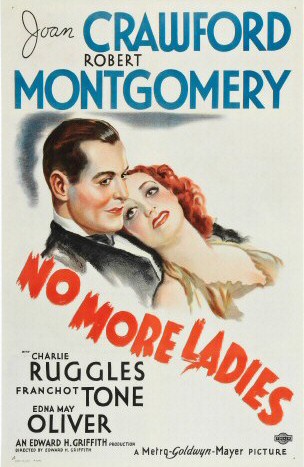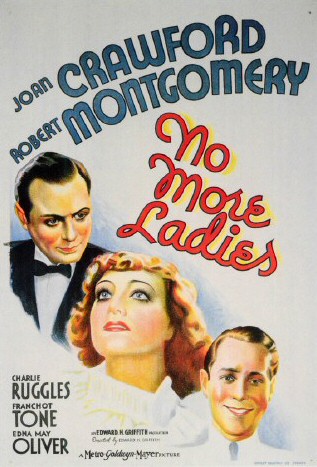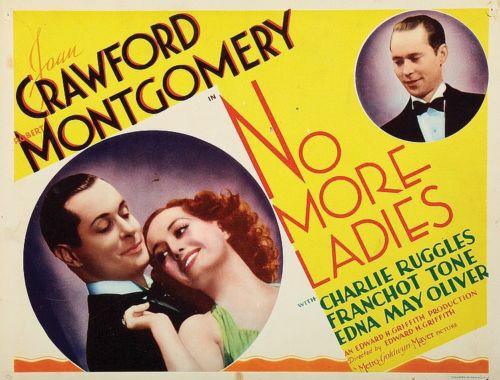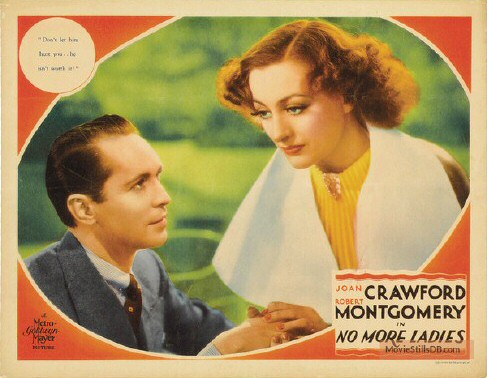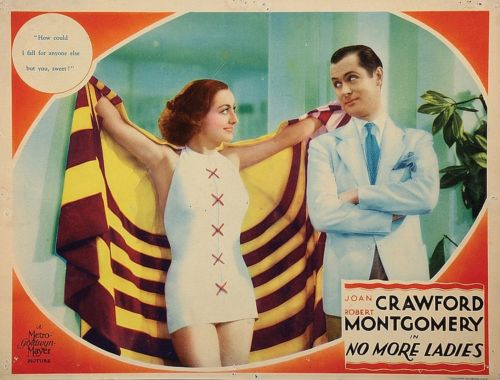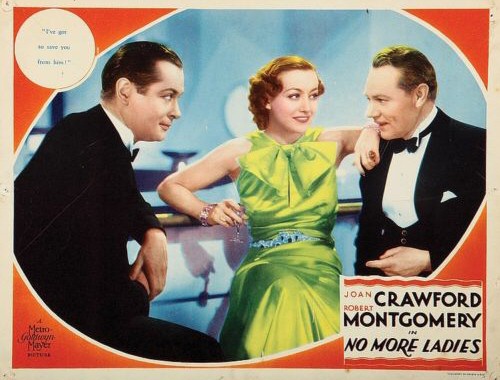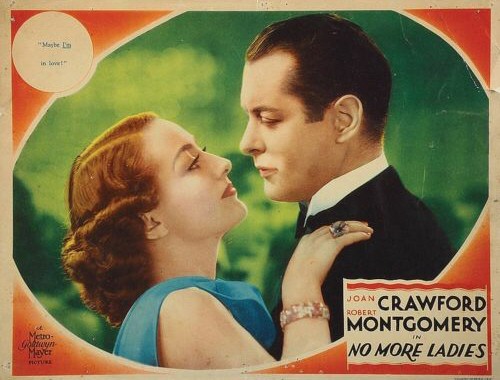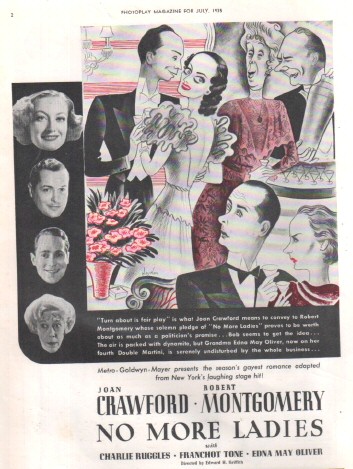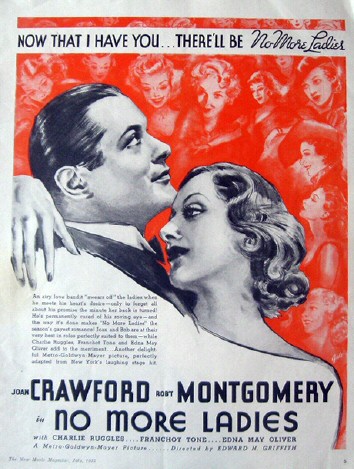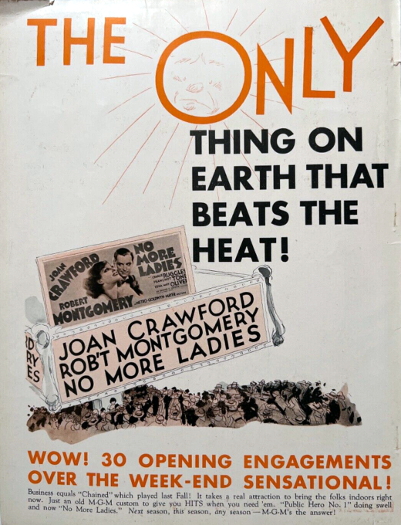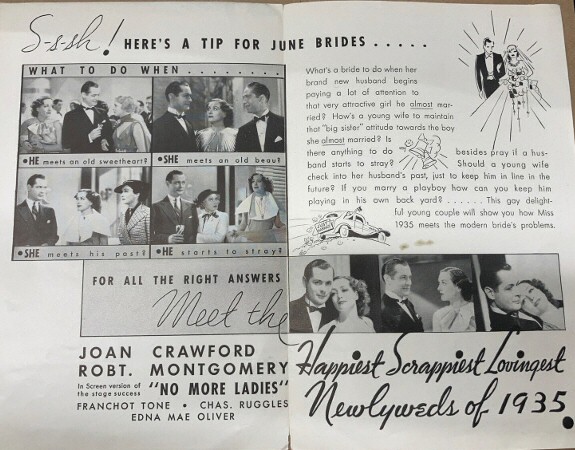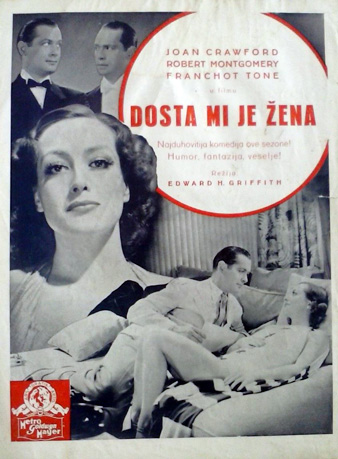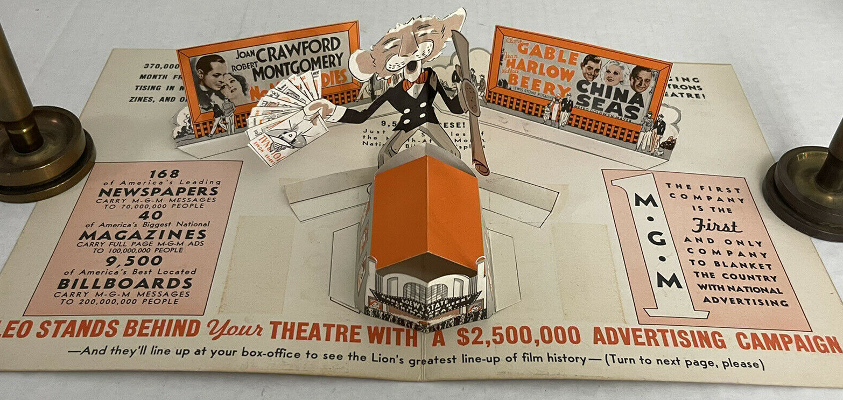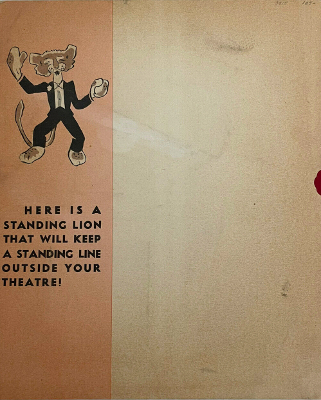|
 Tom C. (August
2023) Tom C. (August
2023)
Rating:    of 5 of 5
No More Ladies,
or so Marcia (Joan) hopes when she and Sheridan Warren (Robert Montgomery) decide to marry in
this 1935 soaper. “Sherry” is a serial womanizer. When he strays---the extent of his indiscretion is left to
your imagination, as NML is post-Code---Marcia concocts a plan to make him jealous by arranging a party with a
guest list that includes several of Sherry’s former dalliances and their
affected male partners. This allows viewers to enjoy a mostly
entertaining assortment of supporting and character actors. Notable cast
includes the following:
Edna May Oliver is Marcia’s granny. EMO was a peach of an actor (https://youtu.be/_AMuCuEsjj0),
stealing scenes and firing off one-liners. My favorite EMO exchange: Sherry: I trust you. Why don't people trust me?
Granny: Maybe it's because they know you.
Charles Ruggles is Sherry’s cousin. He’s annoying and drunk most of the time.
Franchot
Tone is Jim, a victim of Sherry’s philandering. He’d like to turn the
tables on Sherry and steal away Marcia. I think Tone does well in
this film.
Reginald
Denny is Oliver, a suitor of Marcia’s who spends most of his screen
time as set-up man for EMO’s bon mots. (Denny was a star in the early
1920s, but moved to character parts in talkies given the incongruity of
an All-American screen image in silents and his real-life British
accent.)
Arthur Treacher is Lord Knowleton, husband of one of Sherry’s past
conquests. It’s nice to see Treacher play something other than a butler.
He is funny as the mumbling Brit aristocrat who is having a grand time
in the States.
Vivienne
Osborne is amusing as Lady Knowleton, who marches around with a
high-pitched voice referring to everyone by a pet name: Jimsy Wimsy,
Ducky Wucky, etc.
If you blink, you’ll miss the film debut of Joan Fontaine as a Sherry admirer. Ms. Fontaine is billed as Joan Burfield.
Gail
Patrick is the women with whom Sherry has his post-marital dalliance.
It is written that Joan lent Gail duds, her hairdresser, and her make-up man
to shoot her screen test. It was not clear if Joan's generosity extended
to the film itself, but whoever did her up for NML did a great job; Patrick is very lovely here.
Her scene with Joan at the revenge party is also nicely done. (Gail ultimately
went
on to greater professional acclaim as Executive Producer for
the Perry Mason TV series.)
This
is another Joan/Bob formula movie. Both must have been sick of
typecasting by this time. In Joan’s case, the public was also growing a bit
tired of her
schtick, leading to the infamous “Box Office Poison” letter in 1938.
NML was
directed by Edward H. Griffith, of whom I know very little. When he
got sick, George Cukor took over, although without a screen credit. I looked at as many original sources as I could find, but I
could not discern which parts of the movie were directed by Cukor and
which by Griffith. In Conversations, Joan only mentions Cukor
in regard to NML.
Overall,
an amusing story, with well-heeled bon vivants firing off wisecracks
in tuxedos and gowns. Maybe a few more scenes like the aforementioned
one between Gail Patrick and Joan could have further improved
the film. I gave The Shining Hour 2 stars and I Live My Life 3 stars; I liked NML more than the former and about as much as the latter, so 3 stars.
 Stephanie
Jones (March 2023) Stephanie
Jones (March 2023)
Rating:   - 1/2 of
5 - 1/2 of
5
Altogether,
this is a less-painfully forced film to watch than the previous
year's Forsaking All Others, which I actively disliked. The
two films are similar: Both have a high-society love triangle,
both feature Robert Montgomery as a cad, both attempt to be witty,
and both have a notable supporting cast. The differences? Well,
for one thing, there's no awkward "out in the country"
slapstick to watch in No More, which thankfully confines
itself to night-clubs, bars, and drawing rooms and the 1930s
wit that goes along with such. And, overall, the writing here is
just better---unlike the forced wit of Forsaking, the supposedly
funny
lines in No More are actually at least semi-funny and related to the characters
and situations. Both Joan (as Marcia) and Montgomery (as Sherry) are better
here as a result.
As
for the supporting cast: Again, despite the parallels of roles here to
those in Forsaking, in No More Ladies, the supporting
players are actually funny and interesting to watch. Joan's granny,
Fanny (Edna May Oliver), is a wry, bawdy wit (in her high-ball drinking
and game-cheating, similar to the boss's wife in the later Harriet
Craig). Charlie Ruggles has a much-better-written role than
the similar role by Charles Butterworth in Forsaking. And
the primary "other woman" here (though there are
several), played by Gail Patrick, is also more believable than the
one-note dull role by Frances Drake in Forsaking. One mildly
interesting thing: Gail Patrick is a night-club chanteuse that Sherry
met years ago: Her specialty, which she performs at Marcia's party
near the end of the movie, is a banjo-accompanied "All
I Do Is Dream of You"---remember this same act performed by
Gene Raymond in Sadie McKee
in 1934? Another actually humorous spare character is "Ducky"---the
muttering Englishman husband that one of Sherry's exes brings to
the party at the end of the film. And Reginald Denny also has a
briefly funny role as the straight-laced companion to Granny Fanny in
her backgammon games; Denny's Oliver is interested in dating
Joan's Marcia, but that is "about as likely as Jean Harlow
and Mahatma Gandhi" according to Granny!
Given
the semi-clever writing and funny supporting characters, why not
3 stars instead of a mere 2-1/2? Because the non-existent plot is
ridiculous! Montgomery's Sherry is a playboy who constantly fools
around and constantly runs into women he's slept with or wants to
sleep with and still does sleep with. Joan's Marcia thinks she'll
"tame" him by pretending to not care and by pretending
to fool around herself, to arouse his jealousy. At the end of the
film, we're supposed to believe that her gambit has worked and led
to a happy ending. Highly doubtful, despite Marcia's constant sincere
protestations of love. From the beginning, Sherry has demonstrated
that he's a fly-by-night---so Marcia's gaining him in matrimony doesn't
seem particularly meaningful or hopeful.
No
More Ladies is mildly amusing, but there's absolutely nothing
to care about here.
(For
today's classic film fans, however, there is a bit of interesting
trivia: This was the first time that George Cukor directed Joan---he
took over from original director Edward Griffith after Griffith
became ill. And re the very first shot of partiers at the beginning of the film, right
after
the clock: Is that Hal LeSueur, Joan's brother?!)
 Michael Lia (October
2009) Michael Lia (October
2009)
Rating:   - 1/2 of 5 - 1/2 of 5
I
desperately want to elevate this movie to a higher ground. It does have
a lot going for it, and it has always intrigued me... Maybe it is just
the lighting by Oliver T. Marsh that keeps me somewhat impressed, or is it Miss Crawford’s all white silky bedroom or Edna Mae Oliver? I don’t
know. But I keep watching it.
Donald Ogden Stewart’s
screenplay keeps me wondering what else he could have done to the
script. I have only a vague history of the play by A.E. Thomas. Despite
a half-dozen other writers working on the script, not much remains of
the original play. It is quite open about adultery and Miss Crawford
trying to hold on to her husband. The dialogue can sparkle at times, but
I doubt any actress could have done as well as Miss Crawford did.
George Cukor
was called in to bat for an ailing director (E.H. Griffith); he no doubt
tried adding some stage technique to the proceedings, along with stage
veterans Charles Ruggles, Reginald Denny, Arthur Treacher, and Mr. Franchot Tone.
Gosh, for a “motion picture actress,” Joan can hold her own with these stage-trained actors! They elevate the comic tones and it plays well!
Charlie
Ruggles and “Dame” Edna Mae Oliver try to lighten things up, and they
do! Miss Oliver is as brash and candid as her high-balls and chess game!
She is entertaining and does steal the show. She is a true character,
always giving her best. She makes something of “grandma” and has the
best lines in the movie! Lucky lady!
Mr.
Montgomery is very comfortable giving Miss Crawford a hard, dishonest
time. His comedy is always smooth and enjoyable. He can play off
anybody and balances his dashing cad character with a touch of devilish
fun.
Gail Patrick
continues to climb higher; after this film she begins a round of “the
other woman” and “mean girl” roles, to everyone’s advantage. Her career
slumps later, but she stays in the business, creating and producing the “Perry Mason” series on television.
Joan Fontaine
appears in her first screen role under the name “Joan Burfield." It was
not an auspicious beginning. She flutters around a nightclub, and with
bad hair and an awful dress she flits away. I moan at such a wasteful
introduction or no introduction at all.
MGM
is lavish in the production and lets Miss Crawford glimmer throughout!
The supporting cast makes this film well worth viewing, and that is why
I like it!
|  MGM. 79 minutes.
MGM. 79 minutes.

 Tom C. (August
2023)
Tom C. (August
2023)


